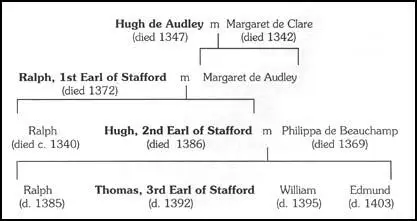Earl of Stafford
When Hugh de Audley died in 1347, Yalding became the property of his only child, Margaret. Her husband, Ralph, Earl of Stafford, became Yalding's new lord of the manor.
Ralph was a keen soldier and between 1338 and 1340 fought with King Edward III in Flanders. On 26th August, 1346, Ralph took part in the sucessful victory over France at the Battle of Crecy. After the battle Edward III gave Ralph the task of counting the dead.
The following year he played a prominent role in the siege of Calais. After the French surrendered Calais, Edward III granted Ralph some property in the town. As a reward for his part in the victory over the French at Poitiers in 1356, Edward granted Ralph land in Ireland.
Ralph died at Tonbridge Castle on 31st August, 1372. His thirty-year old son, Hugh, inherited his large estates. Hugh was married to Philippa, the daughter of Thomas, Earl of Warwick. The couple had four sons and three daughters.
Like his father, Hugh, Earl of Stafford, was an enthusiastic soldier. In the 1370s he was with John of Gaunt on several of his campaigns in France.
Hugh also took a keen interest in politics. In parliament he was a loyal supporter of the monarchy and fully supported the introduction of the poll tax. In May, 1381 he was a member of John of Gaunt's army that marched north to deal with the Scots who were posing a threat to the English border.

Primary Sources
(1) John Brown, A Memoir of Robert Blincoe (1828)
A girl named Mary Richards, who was thought remarkably handsome when she left the workhouse, and, who was not quite ten years of age, attended a drawing frame, below which, and about a foot from the floor, was a horizontal shaft, by which the frames above were turned. It happened one evening, when her apron was caught by the shaft. In an instant the poor girl was drawn by an irresistible force and dashed on the floor. She uttered the most heart-rending shrieks! Blincoe ran towards her, an agonized and helpless beholder of a scene of horror. He saw her whirled round and round with the shaft - he heard the bones of her arms, legs, thighs, etc. successively snap asunder, crushed, seemingly, to atoms, as the machinery whirled her round, and drew tighter and tighter her body within the works, her blood was scattered over the frame and streamed upon the floor, her head appeared dashed to pieces - at last, her mangled body was jammed in so fast, between the shafts and the floor, that the water being low and the wheels off the gear, it stopped the main shaft. When she was extricated, every bone was found broken - her head dreadfully crushed. She was carried off quite lifeless.
